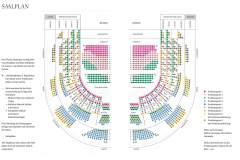La Bohème
December 2025 | ||||||
|---|---|---|---|---|---|---|
Mo | Tu | We | Th | Fr | Sa | Su |
La Bohème – Giacomo Puccini | Opera
Opera in four acts
Libretto by Giuseppe Giacosa & Luigi Illica
after Henri Murger
Act 1 & 2 - 60 MIN
Intermission - 25 MIN
Act 3 & 4 - 60 MIN
Storyline
Act 1
Christmas Eve in the poor garret inhabited by four young artists will hardly differ from any other evening:
Marcello is working on a painting, Rodolfo, poet and writer, is gazing over the rooftops of Paris. They have no money, they are cold and yet they are in good spirits. A bundle of manuscripts only heats the stove for a few moments. Colline, a philosopher by trade, returns home without having achieved anything - the pawnshop was closed.
But the fourth, Schaunard, the musician, is luckier. He tells stories, no one listens - the food he has brought promises a merry Christmas. But Schaunard wants it differently - they go out on Christmas Eve. Danger still looms: the landlord knocks and demands the rent. A glass of wine and the friendliness of the artists cause him to stumble into the trap; with a wink, he talks of a love adventure, reason enough for the friends to show him the door with well-played moral indignation.
Rodolfo stays to finish an article while the others go ahead to Café Momus. There is a knock: a young woman is outside, she wants to light the extinguished candle. Tormented by a cough, she collapses. Then, grateful for the help she has been given, she wants to leave again; but the key to the apartment has been lost, not entirely by chance, and the draught has extinguished all the lights. The hands are found in the darkness. She is called Mimì, she lets them know, she embroiders flowers... Outside, friends are calling.
Christmas Eve has lost its gloom.
Act 2
The student district of Paris presents a colorful picture. Crowds of people roam the streets. Rodolfo buys his Mimì a bonnet and invites her to the Café Momus, introduces her to his friends and enjoys their admiration.
The student district of Paris presents a colorful picture. Crowds of people roam the streets. Rodolfo buys his Mimì a bonnet and invites her to the Café Momus, introduces her to his friends and enjoys their admiration.
Only Marcello has grief and his grief has a name: Musetta. She appears at the side of an old and rich gallant with the firm intention of pulling out all the stops in the art of seduction. Marcello is unable to cope with this public onslaught and an old, great love is rekindled.
Act 3
A gloomy February morning at the customs barrier that separates a Parisian suburb from the city center.
Workers, carters and milkwomen are let through and pass by the tavern, which is adorned with a half-finished painting of Marcello. The wind seems to carry Musetta's voice. It is cold, Mimì has had an argument with Rodolfo, Marcello is supposed to mediate. Rodolfo seems to be running away from her, she doesn't know why.
Marcello does not suspect the real reasons either; Rodolfo reveals them to him: Mimì is terminally ill, she only has a short time to live and he cannot bear to see her suffer. He has to endure even more: Mimì has overheard her death sentence, a fit of coughing betrays her presence. And Rodolfo's love succeeds in doing the hardest thing: softening his despair, bringing peace to his tortured heart. Strange contrast: Marcello and Musetta. Their love seems to seek out conflict.
Act 4
Three or four months have passed. Marcello and Rodolfo have lost their lovers. They sit at work thinking. Where is Musetta, where is Mimì? Can the carefree days of yesteryear be repeated?
It almost seems so: as soon as Schaunard and Collin arrive with a few poor provisions, the mood improves; they try to bring out the old cheerfulness, play theater, dance, duel... Musetta brings Mimì in.
Mimì is marked by death. Everyone tries to help her; she gratefully recognizes her friends. Musetta and Marcello are united by her gaze. Musetta sacrifices her earrings to fulfill the sick woman's last wish: a muff. And Collin, a philosopher with a heart, transfers his old coat. Rodolfo stays with the dying woman; they are alone with their memories. The friends return with their gifts, a final joy for Mimì. She slumbers gently away.
Program and cast
Rodolfo – Juan Diego Flórez
Mimì – Nicole Car
Marcello – Andrey Zhilikovsky
Schaunard – Jusung Gabriel Park
Colline – Ivo Stanchev
Musetta – Anna Bondarenko
Conductor – Giacomo Sagripanti
Direction and Set Design – Franco Zeffirelli
Costumes – Marcel Escoffier
Vienna State Opera
Public Transport
Subway lines: U1, U2, U4
Trams: 1, 2, D, J, 62, 65
Buses: 59A
Local Railway: Badner Bahn
Stops: Karlsplatz / Opera
Taxi stands are available nearby.
Parking
Parking is only € 6, - for eight hours!
The Wiener Staatsoper and the ÖPARK Kärntner Ring Garage on Mahlerstraße 8, under the “Ringstraßengalerien”, offer the patrons of the Vienna State Opera a new, reduced parking fee. You can park in the Kärntner Ring Garage for up to 8 hours and pay only a flat fee of € 6, -. Just validate your ticket at one of the discount machines inside the Wiener Staatsoper. The normal rate will be charged for parking time greater than 8 hours. The validation machines can be found at the following coat checks: Operngasse, Herbert von Karajan-Platz, and the right and left and balcony galleries.
Important: In order to get the discount, please draw a ticket and do not use your credit card when entering the garage!
After devaluing your ticket in the Wiener Staatsoper you can pay comfortably by credit card or cash at the vending machines.
The machines accept coins and bills up to 50.- Euro. Parking time longer than 8 hours will be charged at the normal rate.
History
The structure of the opera house was planned by the Viennese architect August Sicard von Sicardsburg, while the inside was designed by interior decorator Eduard van der Nüll. It was also impacted by other major artists such as Moritz von Schwind, who painted the frescoes in the foyer, and the famous "Zauberflöten" (“Magic Flute”) series of frescoes on the veranda. Neither of the architects survived to see the opening of ‘their’ opera house: the sensitive van der Nüll committed suicide, and his friend Sicardsburg died of a stroke soon afterwards.
On May 25, 1869, the opera house solemnly opened with Mozart's Don Giovanni in the presence of Emperor Franz Joseph and Empress Elisabeth.
The popularity of the building grew under the artistic influence of the first directors: Franz von Dingelstedt, Johann Herbeck, Franz Jauner, and Wilhelm Jahn. The Vienna opera experienced its first high point under the direction of Gustav Mahler. He completely transformed the outdated performance system, increased the precision and timing of the performances, and also utilized the experience of other noteworthy artists, such as Alfred Roller, for the formation of new stage aesthetics.
The years 1938 to 1945 were a dark chapter in the history of the opera house. Under the Nazis, many members of the house were driven out, pursued, and killed, and many works were not allowed to be played.
On March 12, 1945, the opera house was devastated during a bombing, but on May 1, 1945, the “State Opera in the Volksoper” opened with a performance of Mozart's THE MARRIAGE OF FIGARO. On October 6, 1945, the hastily restored “Theaters an der Wien” reopened with Beethoven's FIDELIO. For the next ten years the Vienna State Opera operated in two venues while the true headquarters was being rebuilt at a great expense.
The Secretary of State for Public Works, Julius Raab, announced on May 24, 1945, that reconstruction of the Vienna State Opera would begin immediately. Only the main facade, the grand staircase, and the Schwind Foyer had been spared from the bombs. On November 5, 1955, the Vienna State Opera reopened with a new auditorium and modernized technology. Under the direction of Karl Böhm, Beethoven’s FIDELIO was brilliantly performed, and the opening ceremonies were broadcast by Austrian television. The whole world understood that life was beginning again for this country that had just regained its independence.
Today, the Vienna State Opera is considered one of the most important opera houses in the world; in particular, it is the house with the largest repertoire. It has been under the direction of Dominique Meyer since September 1, 2010.

 EN
EN DE
DE IT
IT FR
FR ES
ES RU
RU JP
JP RO
RO
 Seating plan
Seating plan